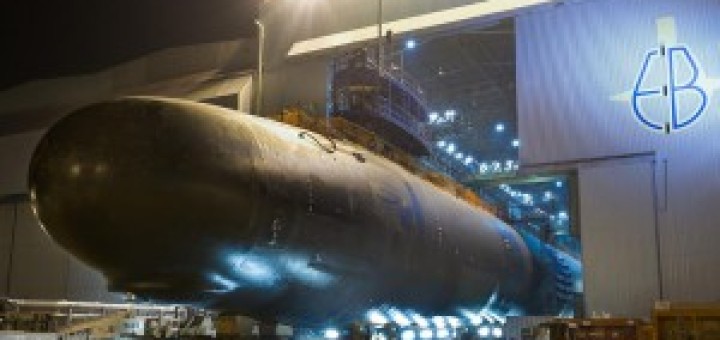Echo Dot (5th Gen, 2022 release) | With bigger vibrant sound, helpful routines and Alexa | Charcoal
$49.99 (as of April 6, 2024 05:59 GMT +00:00 - More infoProduct prices and availability are accurate as of the date/time indicated and are subject to change. Any price and availability information displayed on [relevant Amazon Site(s), as applicable] at the time of purchase will apply to the purchase of this product.)By Lt. Cmdr. Ben Amdur
Officer in Charge of the Historic Ship Nautilus (SSN 571) and the Director of the Submarine Force Museum
On Nov. 2, 2013 Precommissioning Unit North Dakota (SSN 784) will be christened at the Electric Boat Ship Yard in Groton, Conn., launching the most advanced submarine in U.S. Naval history. The christening ceremony is a time-honored tradition which has roots dating back to Babylonian times. North Dakota’s will take place at the same shipyard nearly 60 years after USS Nautilus (SSN 571) was christened and launched, bringing nuclear propulsion to the fleet and the world.
Six decades, thousands of nuclear-trained officers and Sailors, and more than 200 nuclear-powered submarines later, PCU North Dakota raises the bar to a new zenith. Transferring from the initial manning crew of North Dakota to the Historic Ship Nautilus a few months ago has afforded me the opportunity to appreciate the similarities and changes in both of these remarkable ships.
The Navy’s 11th Virginia-class attack submarine Pre-Commissioning Unit North Dakota (SSN 784) is rolled out of an indoor shipyard facility at the General Dynamics Electric Boat (GDEB) Groton, Conn., Sept. 11.
North Dakota & Nautilus – the Comparison
The first and most obvious comparison between the two submarines are the physical and technological differences that help us appreciate how far we have come in 60 years. USS Nautilus joined the fleet in 1954 as the most advanced ship a nation had ever put to sea.

In this file photo taken Jan. 21, 1954, spectators gather around the nuclear-powered submarine USS Nautilus (SSN 571) during a christening ceremony.
Today’s state-of-the-art North Dakota is 57 feet longer, six feet wider abeam (diameter), nearly twice the displacement of Nautilus and is significantly faster, deeper diving, and immensely quieter. Naturally, North Dakota is packed with sensors, weapons, computers, and communication technology that were unimaginable to even the science fiction of the 1950s, but what amazes me the most is how far our reactor and propulsion plant design has come.
To the general public touring either ship, the compactness of the spaces and crew accommodations is often their strongest memory. For a different opinion, ask a diesel boat veteran for a comparison and you’ll walk away thinking that our nuclear powered boats are veritable luxury liners. Nautilus established a new and much improved standard for submarine crew accommodations that has carried through to North Dakota. I personally find the officer and senior enlisted accommodations on Nautilus to be superior, although the junior enlisted berthing spaces are clearly improved on our more modern subs like North Dakota.
To the qualified submariner, the differences between the two boats are easy to pick out mainly because of how much they still have in common. I regularly see Sailors from locally based submarines here in Connecticut and support commands leading tours of Nautilus for their family and friends. Most do not realize that many of the features they take for granted were new with Nautilus, including three decks (vice one), stairways, crew racks (vice a mix of racks and hammocks), the size of the crew’s mess (dining area), much of the atmosphere control equipment, ship-wide air conditioning, and the availability of fresh water. The similarities are striking because the capabilities that nuclear powered submarines give our nation are timeless: Stealth, Endurance, Agility, and Firepower.
Submarine force leaders will readily tell you their most important assets are the people that man our submarine fleet. They are among the most intelligent and highly-trained people in the Navy; an exacting standard that was set by Nautilus and her initial crew.
Shaping the Nuclear Naval Force
The more than a year of advanced technical training that all nuclear-qualified submarine officers and enlisted crew members must receive before assignment to their first boat began with the same training for that first Nautilus crew at the SW-1 prototype in Arco, Idaho. The choice not to separate the nuclear engineering officers from the navigation and tactical officer positions of the submarine’s wardroom also began with Nautilus.
Then Lt. Cmdr. Eugene P. Wilkinson was a decorated WWII submarine officer and had already served as the Executive Officer of three submarines when he was assigned to Oak Ridge National Laboratory to work for the legendary Capt. Hyman G. Rickover, the “father” of the nuclear Navy, as part of the team designing what would become Nautilus’ propulsion plant. His selection as Nautilus’ first skipper was followed by tours as the commanding officer of USS Volodor (SS 490) and USS Wahoo (SS 565). PCU North Dakota’s Commanding Officer, Capt. (select) Douglas Gordon, continues this tradition. He has extensive engineering experience, including a tour as the Engineer Officer on USS Louisiana (SSBN 743), as well as proving himself as a submarine tactician, leader, and warrior.
While most nations separate the career paths of the ship’s nuclear engineers from the ship drivers; every successful U.S. nuclear submarine line officer qualifies to operate and lead both the engineering plant and the combat, navigation, and ship control teams. The philosophy behind this decision is simple, the best submarine officers understand every capability of their crew and ships.
The christening of PCU North Dakota (SSN 784) will be streamed live on Saturday, Nov. 2 at 10 a.m. on navy.mil and The Pentagon Channel.
Lt. Cmdr. Ben Amdur is the Officer in Charge of the Historic Ship Nautilus (SSN 571) and the Director of the Submarine Force Museum. Prior to taking charge of the Nautilus, he served as PCU North Dakota’s first Engineer Officer.
The preceeding article is provided as part of the Navy Mentor News Service. The original post can be viewed on http://navylive.dodlive.mil













